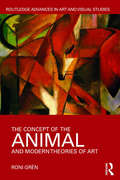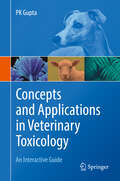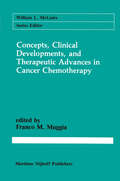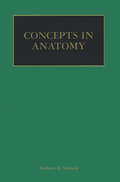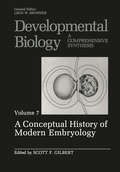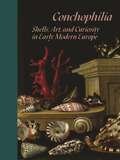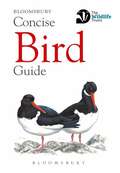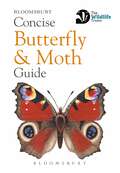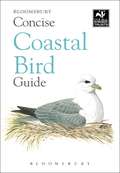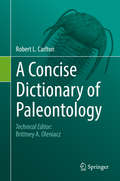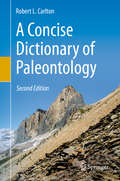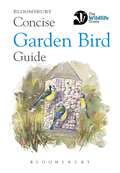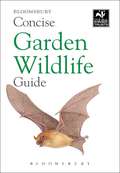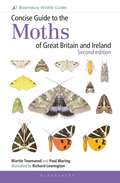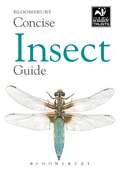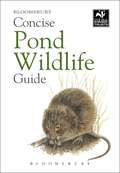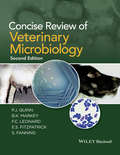- Table View
- List View
The Concept of the Animal and Modern Theories of Art (Routledge Advances in Art and Visual Studies)
by Roni GrénThis book examines the importance of the animal in modern art theory, using classic texts of modern aesthetics and texts written by modern artists to explore the influence of the human-animal relationship on nineteenth and twentieth century artists and art theorists. The book is unique due to its focus on the concept of the animal, rather than on images of animals, and it aims towards a theoretical account of the connections between the notions of art and animality in the modern age. Roni Grén’s book spans various disciplines, such as art theory, art history, animal studies, modernism, postmodernism, posthumanism, philosophy, and aesthetics.
Concepts and Applications in Veterinary Toxicology: An Interactive Guide
by PK GuptaThis book: “Concepts and Applications in Veterinary Toxicology: An Interactive Guide”: covers a broad spectrum of topics related to students specializing in veterinary toxicology and for veterinary medical practitioners. Since the major emphasis of the book is to teach veterinary students, therefore more attention has been given to common toxicants to which several species are exposed including pet animals. The subject of veterinary toxicology is complicated greatly by the wide variations in responses of domestic, companion, aquatic, wild, and zoo species to toxicants. Therefore, emphasis has also been given to species variation and diagnostic toxicology including clinical management that is more relevant to veterinary profession.Key Features· Highlights specialized topics essential for veterinary specialists.· Covers a variety of common toxicants to which several species including pet animals are exposed.· Includes sample questions and answers that are extremely valuable for students, clinical pharmacists, teachers, and academicians in preparing for their board and other examinations.
Concepts, Clinical Developments, and Therapeutic Advances in Cancer Chemotherapy (Cancer Treatment and Research #36)
by Franco M. MuggiaWhere do you begin to look for a recent, authoritative article on the diagnosis or management of a particular malignancy? The few general oncology textbooks are generally out of date. Single papers in specialized journals are informative but seldom comprehensive; these are more often preliminary reports on a very limited number of patients. Certain general journals frequently publish good indepth reviews of cancer topics, and published symposium lectures are often the best overviews available. Unfor tunately, these reviews and supplements appear sporadically, and the reader can never be sure when a topic of special interest will be covered. Cancer Treatment and Research is a series of authoritative volumes which aim to meet this need. It is an attempt to establish a critical mass of oncology literature covering virtually all oncology topics, revised frequently to keep the coverage up to date, easily available on a single library shelf or by a single personal subscription. We have approached the problem in the following fashion. First, by dividing the oncology literature into specific subdivisions such as lung can cer, genitourinary cancer, pediatric oncology, etc. Second, by asking emi nent authorities in each of these areas to edit a volume on the specific topic on an annual or biannual basis. Each topic and tumor type is covered in a volume appearing frequently and predictably, discussing current diagnosis, staging, markers, all forms of treatment modalities, basic biology, and more.
Concepts in Anatomy
by Herbert H. SrebnikAnatomy, to be sure, is the essential foundation of clinical practice, but it is much more than that. First and foremost, anatomy is a biological science. There is order and logic to the organization of the human body and the arrangement of its parts. And, as all sciences, anatomy offers challenge and discovery. Concepts in Anatomy is not a textbook, but more of a brief handbook that is selective rather than encyclopedic in scope, conception rather than particular in its approach. It stresses general principles, so as to minimize rote learning, and it provides order and direction to the study of gross anatomy. Anatomy is inherently complicated and confusing; this volume helps you make sense of it in a way that also aims to inspire its study. Richly illustrated with original drawings, Concepts in Anatomy is a valuable resource for anyone currently studying or teaching the subject, or as a reference for advanced researchers.
A Conceptual History of Modern Embryology: Volume 7: A Conceptual History of Modern Embryology (Developmental Biology #7)
by Scott F. Gilbert"Glory to the science of embryology!" So Johannes Holtfreter closed his letter to this editor when he granted permission to publish his article in this volume. And glory there is: glory in the phenomenon of animals developing their complex morphologies from fertilized eggs, and glory in the efforts of a relatively small group of scientists to understand these wonderful events. Embryology is unique among the biological disciplines, for it denies the hegemony of the adult and sees value (indeed, more value) in the stages that lead up to the fully developed organism. It seeks the origin, and not merely the maintenance, of the body. And if embryology is the study of the embryo as seen over time, the history of embryology is a second-order derivative, seeing how the study of embryos changes over time. As Jane Oppenheimer pointed out, "Sci ence, like life itself, indeed like history, itself, is a historical phenomenon. It can build itself only out of its past. " Thus, there are several ways in which embryology and the history of embryology are similar. Each takes a current stage of a developing entity and seeks to explain the paths that brought it to its present condition. Indeed, embryology used to be called Entwicklungsgeschichte, the developmental history of the organism. Both embryology and its history interpret the interplay between internal factors and external agents in the causation of new processes and events.
Conchophilia: Shells, Art, and Curiosity in Early Modern Europe
by Marisa Anne Bass Anne Goldgar Hanneke Grootenboer Claudia SwanA captivating historical look at the cultural and artistic significance of shells in early modern EuropeAmong nature’s most artful creations, shells have long inspired the curiosity and passion of artisans, artists, collectors, and thinkers. Conchophilia delves into the intimate relationship between shells and people, offering an unprecedented account of the early modern era, when the influx of exotic shells to Europe fueled their study and representation as never before. From elaborate nautilus cups and shell-encrusted grottoes to delicate miniatures, this richly illustrated book reveals how the love of shells intersected not only with the rise of natural history and global trade but also with philosophical inquiry, issues of race and gender, and the ascent of art-historical connoisseurship.Shells circulated at the nexus of commerce and intellectual pursuit, suggesting new ways of thinking about relationships between Europe and the rest of the world. The authors focus on northern Europe, where the interest and trade in shells had its greatest impact on the visual arts. They consider how shells were perceived as exotic objects, the role of shells in courtly collections, their place in still-life tableaus, and the connections between their forms and those of the human body. They examine how artists gilded, carved, etched, and inked shells to evoke the permeable boundary between art and nature. These interactions with shells shaped the ways that early modern individuals perceived their relation to the natural world, and their endeavors in art and the acquisition of knowledge.Spanning painting and print to architecture and the decorative arts, Conchophilia uncovers the fascinating ways that shells were circulated, depicted, collected, and valued during a time of remarkable global change.
Conchophilia: Shells, Art, and Curiosity in Early Modern Europe
by Marisa Anne Bass Anne Goldgar Hanneke Grootenboer Claudia SwanA captivating historical look at the cultural and artistic significance of shells in early modern EuropeAmong nature’s most artful creations, shells have long inspired the curiosity and passion of artisans, artists, collectors, and thinkers. Conchophilia delves into the intimate relationship between shells and people, offering an unprecedented account of the early modern era, when the influx of exotic shells to Europe fueled their study and representation as never before. From elaborate nautilus cups and shell-encrusted grottoes to delicate miniatures, this richly illustrated book reveals how the love of shells intersected not only with the rise of natural history and global trade but also with philosophical inquiry, issues of race and gender, and the ascent of art-historical connoisseurship.Shells circulated at the nexus of commerce and intellectual pursuit, suggesting new ways of thinking about relationships between Europe and the rest of the world. The authors focus on northern Europe, where the interest and trade in shells had its greatest impact on the visual arts. They consider how shells were perceived as exotic objects, the role of shells in courtly collections, their place in still-life tableaus, and the connections between their forms and those of the human body. They examine how artists gilded, carved, etched, and inked shells to evoke the permeable boundary between art and nature. These interactions with shells shaped the ways that early modern individuals perceived their relation to the natural world, and their endeavors in art and the acquisition of knowledge.Spanning painting and print to architecture and the decorative arts, Conchophilia uncovers the fascinating ways that shells were circulated, depicted, collected, and valued during a time of remarkable global change.
Concise Bird Guide
by BloomsburyThis beautifully illustrated mini field guide is packed with information on the birds of Britain and the near Continent. It covers more than 250 species, which are illustrated with superb full-colour artworks that show – where relevant – variations in plumage, for example for male, female and juvenile birds, and breeding and non-breeding birds. A concise written account covering size, description, voice, habitat, distribution and habits appears on the same page.The easy-to-follow layouts and superb artworks aid quick and accurate identification, and make this book an indispensable reference in the field as well as at home. It is compact enough to fit in the pocket, yet packed with essential information for the nature enthusiast.Renowned natural history artists Richard Allen, David Daly, Szabolcs Kokay, Dan Cole and Steven Message painted the illustrations.
Concise Bird Guide
by BloomsburyThis beautifully illustrated mini field guide is packed with information on the birds of Britain and the near Continent. It covers more than 250 species, which are illustrated with superb full-colour artworks that show – where relevant – variations in plumage, for example for male, female and juvenile birds, and breeding and non-breeding birds. A concise written account covering size, description, voice, habitat, distribution and habits appears on the same page.The easy-to-follow layouts and superb artworks aid quick and accurate identification, and make this book an indispensable reference in the field as well as at home. It is compact enough to fit in the pocket, yet packed with essential information for the nature enthusiast.Renowned natural history artists Richard Allen, David Daly, Szabolcs Kokaym Dan Cole and Steven Message painted the illustrations.
Concise Butterfly and Moth Guide
by BloomsburyThis beautifully illustrated mini field guide is packed with information on the butterflies and moths of Britain and the near Continent. It covers more than 150 species, all of which are illustrated with superb full-colour artworks that show – where relevant – variations in colour, for example for male and female butterflies, as well as some of the most spectacular caterpillars.A concise written account covering size, description, habitat, flight times, distribution, foodplants and habits appears on the same page.The easy-to-follow layouts and superb artworks aid quick and accurate identification, and make this book an indispensable reference in the field as well as at home. It is compact enough to fit in the pocket, yet packed with essential information for the nature enthusiast.
Concise Butterfly and Moth Guide
by BloomsburyThis beautifully illustrated mini field guide is packed with information on the butterflies and moths of Britain and the near Continent. It covers more than 150 species, all of which are illustrated with superb full-colour artworks that show – where relevant – variations in colour, for example for male and female butterflies, as well as some of the most spectacular caterpillars.A concise written account covering size, description, habitat, flight times, distribution, foodplants and habits appears on the same page.The easy-to-follow layouts and superb artworks aid quick and accurate identification, and make this book an indispensable reference in the field as well as at home. It is compact enough to fit in the pocket, yet packed with essential information for the nature enthusiast.
Concise Coastal Bird Guide
by Bloomsbury PublishingThis beautifully illustrated mini field guide is packed with information on the coastal birds of Britain and the near Continent. It covers more than 170 species, which are illustrated with superb full-colour artworks that show - where relevant - variations in plumage, for example for male, female and juvenile birds, and breeding and non-breeding birds. A concise written account covering size, description, voice, habitat, distribution and habits appears on the same page.The easy-to-follow layouts and superb artworks aid quick and accurate identification, and make this book an indispensable reference in the field as well as at home. It is compact enough to fit in the pocket yet packed with essential information for the nature enthusiast. To protect it against the elements, the book is wrapped in a durable plastic wallet. Also included is a foldout insert illustrating such topics as variations in plumage in flying birds of different species.Renowned natural history artists Richard Allen, David Daly, Szabolc Kokay, Dan Cole and Stephen Message painted the artworks.
Concise Coastal Bird Guide (The Wildlife Trusts)
by Bloomsbury PublishingThis beautifully illustrated mini field guide is packed with information on the coastal birds of Britain and the near Continent. It covers more than 170 species, which are illustrated with superb full-colour artworks that show - where relevant - variations in plumage, for example for male, female and juvenile birds, and breeding and non-breeding birds. A concise written account covering size, description, voice, habitat, distribution and habits appears on the same page.The easy-to-follow layouts and superb artworks aid quick and accurate identification, and make this book an indispensable reference in the field as well as at home. It is compact enough to fit in the pocket yet packed with essential information for the nature enthusiast. To protect it against the elements, the book is wrapped in a durable plastic wallet. Also included is a foldout insert illustrating such topics as variations in plumage in flying birds of different species.Renowned natural history artists Richard Allen, David Daly, Szabolc Kokay, Dan Cole and Stephen Message painted the artworks.
A Concise Dictionary of Paleontology
by Robert L. CarltonThis authored dictionary presents a unique glossary of paleontological terms, taxa, localities, and concepts, with focus on the most significant orders, genera, and species in terms of historical turning points such as mass extinctions. The book is an accurate and up-to-date collection of the most important paleontological terms and taxa, and may be used as a resource by students, researchers, libraries, and museums.Though useful to many in professional and academic settings, the book is also aimed at general readers of scientific literature who may enjoy the material without a background in paleontology. While there are many current resources on the subject, few fully encapsulate an accurate representation of the paleontological lexicon. This book attempts to compile such a representation in a moderately comprehensive manner, and includes a list of the most important monographs and articles that have been consulted to put together this essential work.
A Concise Dictionary of Paleontology: Second Edition
by Robert L. CarltonThis new and significantly updated authored dictionary is a unique glossary of paleontological terms, taxa, localities, and concepts. It focuses primarily on identifying the most significant groups of fossil animals and plants in relation to their evolution and phylogeny. It also focuses on mass extinctions, on taxa that are problematic in some significant way, on the principal fossil-Lagerstätten of the world, and on historical turning points marked by index fossils. Although there are many current resources on the subject, none contains an accurate representation of the paleontological lexicon. Although well aware that the fast-changing field of paleontology will always defy any attempt at complete description, the author has attempted to provide an accurate and comprehensive set of about 4,000 entries that will be useful to professionals as well as to general readers of scientific literature without a background in paleontology.
Concise Garden Bird Guide (Concise Guides)
by BloomsburyThis beautifully illustrated mini field guide is first and foremost a garden bird identification guide containing detailed descriptions of the most commonly encountered species, as well as some rarities and birds you may only see flying overhead in gardens. Eighty-eight species, illustrated with more than 400 superb full-colour artworks, are covered. The book also includes general guidelines on food, feeders, nest boxes and other items that can greatly increase the presence of birds in your garden. A concise written account for each species covers data such as size, general description, voice, habitat, food, occurrence in gardens, and distribution in Britain and the near Continent. The easy-to-follow layouts and superb artworks aid quick and accurate identification, making the book an indispensable reference in the field as well as in the home and garden.The illustrators include renowned natural history artists Sandra Doyle, Dan Cole, Szabolcs Kokay, Steven Message, Bridgette James and David Sutton.
Concise Garden Bird Guide
by BloomsburyThis beautifully illustrated mini field guide is first and foremost a garden bird identification guide containing detailed descriptions of the most commonly encountered species, as well as some rarities and birds you may only see flying overhead in gardens. Eighty-eight species, illustrated with more than 400 superb full-colour artworks, are covered. The book also includes general guidelines on food, feeders, nest boxes and other items that can greatly increase the presence of birds in your garden. A concise written account for each species covers data such as size, general description, voice, habitat, food, occurrence in gardens, and distribution in Britain and the near Continent. The easy-to-follow layouts and superb artworks aid quick and accurate identification, making the book an indispensable reference in the field as well as in the home and garden.The illustrators include renowned natural history artists Sandra Doyle, Dan Cole, Szabolcs Kokay, Steven Message, Bridgette James and David Sutton.
Concise Garden Wildlife Guide
by BloomsburyThis beautifully illustrated concise guide is packed with information on the wildlife that can be found in Britain and the near Continent, including mammals, birds, reptiles, amphibians, insects, molluscs, and crustaceans. It covers around 200 species, all of which are illustrated with superb full-colour artworks. A concise written account covering size, description, voice, habitat, distribution and habits appears on the same page as the illustration for each species. The easy-to-follow layouts and superb artworks aid quick and accurate identification, and make this book an invaluable reference outdoors as well as at home.To protect it against the elements, the book is wrapped in a durable plastic wallet. Also included is a fold-out insert illustrating differences between similar species, and assisting in quick identification.Renowned natural history artists Sandra Doyle, Stuart Carter, David Daly and Lyn Wells painted the illustrations.
Concise Garden Wildlife Guide
by BloomsburyThis beautifully illustrated concise guide is packed with information on the wildlife that can be found in Britain and the near Continent, including mammals, birds, reptiles, amphibians, insects, molluscs, and crustaceans. It covers around 200 species, all of which are illustrated with superb full-colour artworks. A concise written account covering size, description, voice, habitat, distribution and habits appears on the same page as the illustration for each species. The easy-to-follow layouts and superb artworks aid quick and accurate identification, and make this book an invaluable reference outdoors as well as at home.To protect it against the elements, the book is wrapped in a durable plastic wallet. Also included is a fold-out insert illustrating differences between similar species, and assisting in quick identification.Renowned natural history artists Sandra Doyle, Stuart Carter, David Daly and Lyn Wells painted the illustrations.
Concise Guide to the Moths of Great Britain and Ireland: Second edition
by Martin Townsend Paul Waring'A remarkable field guide ... one of those books that come along every now and then and cause a revolution.'Michael McCarthyIndependentThis concise guide is a companion to the main Field Guide to the Moths of Great Britain and Ireland by the same expert authors, but is in a condensed form with artwork opposite the species descriptions and lay-flat binding for ease of use in the field. It includes brief but comprehensive field descriptions of all the macro-moths in Great Britain, Ireland, the Isle of Man and the Channel Islands, and this second edition has been thoroughly revised and updated to reflect the latest advances in taxonomy. Featuring more than 1,700 superbly detailed colour artworks and covering nearly 900 species, this portable guide is an essential addition to every moth-lover's field kit.
Concise Insect Guide
by BloomsburyThis beautifully illustrated pocket field guide is packed with information on the marvellous variety of insects that inhabits Britain and the near Continent. It includes more than 180 species, including dragonflies, bees, wasps, beetles, bugs and flies, all of which are illustrated with superb full-colour artworks. A concise written account covering size, description, habitat, distribution, foodplants and habits appears on the same page as the illustrations for each species. The easy-to-follow layouts and superb artworks aid quick and accurate identification, and make this book an indispensable reference in the field as well as at home.Renowned natural history artists Sandra Doyle and Stuart Carter painted the illustrations.
Concise Insect Guide
by BloomsburyThis beautifully illustrated pocket field guide is packed with information on the marvellous variety of insects that inhabits Britain and the near Continent. It includes more than 180 species, including dragonflies, bees, wasps, beetles, bugs and flies, all of which are illustrated with superb full-colour artworks. A concise written account covering size, description, habitat, distribution, foodplants and habits appears on the same page as the illustrations for each species. The easy-to-follow layouts and superb artworks aid quick and accurate identification, and make this book an indispensable reference in the field as well as at home.Renowned natural history artists Sandra Doyle and Stuart Carter painted the illustrations.
Concise Pond Wildlife Guide
by BloomsburyThis beautifully illustrated mini field guide is packed with information on more than 190 species of animal and plant that inhabit still-water bodies such as ponds, pools and small lakes in northern Europe. A vast number of species occurs in these habitats, so the book is selective, but it pictures and describes a good range of fauna and flora that are likely to be found and identified. Among the fascinating animals featured are freshwater sponges, hydras, water bears, worms, leeches, water snails, dragonflies and damselflies, frogs and toads, bats, fish, birds, and iconic mammals such as the Water Vole and European Otter. All the species are illustrated with superb full-colour artworks, and a concise written account for each covers data such as size, general description, habitat, ecology, and distribution in Britain and the near Continent. The easy-to-follow layouts and superb artworks aid quick and accurate identification, making the book an indispensable reference in the field as well as in the home and garden. It is wrapped in a durable plastic wallet to protect it against the elements in the field.
Concise Pond Wildlife Guide
by BloomsburyThis beautifully illustrated mini field guide is packed with information on more than 190 species of animal and plant that inhabit still-water bodies such as ponds, pools and small lakes in northern Europe. A vast number of species occurs in these habitats, so the book is selective, but it pictures and describes a good range of fauna and flora that are likely to be found and identified. Among the fascinating animals featured are freshwater sponges, hydras, water bears, worms, leeches, water snails, dragonflies and damselflies, frogs and toads, bats, fish, birds, and iconic mammals such as the Water Vole and European Otter. All the species are illustrated with superb full-colour artworks, and a concise written account for each covers data such as size, general description, habitat, ecology, and distribution in Britain and the near Continent. The easy-to-follow layouts and superb artworks aid quick and accurate identification, making the book an indispensable reference in the field as well as in the home and garden. It is wrapped in a durable plastic wallet to protect it against the elements in the field.
Concise Review of Veterinary Microbiology
by P. J. Quinn B. K. Markey F. C. Leonard E. S. Fitzpatrick S. FanningUpdated to reflect the latest developments in the field, Concise Review of Veterinary Microbiology, 2nd Edition, presents essential information on veterinary microbiology for students and those requiring a refresher on key topics relating to microbial diseases in animals. Morphological, cultural and other descriptive features of pathogenic microorganisms are described, together with their habitats and aetiological roles in disease production in animals and, where appropriate, in the human population. Key features:• There are five sections covering bacteriology, mycology, virology, biosecurity and other aspects of infectious diseases• Provides concise, yet comprehensive information on pathogenic microorganisms of importance in veterinary medicine, the diseases which they cause, their diagnosis and control• The 79 short chapters in this book include 13 new chapters on antibacterial resistance, structure and function of the immune system, antifungal chemotherapy, antiviral chemotherapy, principles of biosecurity and a number of topics related to the control and prevention of infectious diseases• This latest edition uses updated nomenclature and includes detailed diagrams now in full colour, and comprehensive tables
